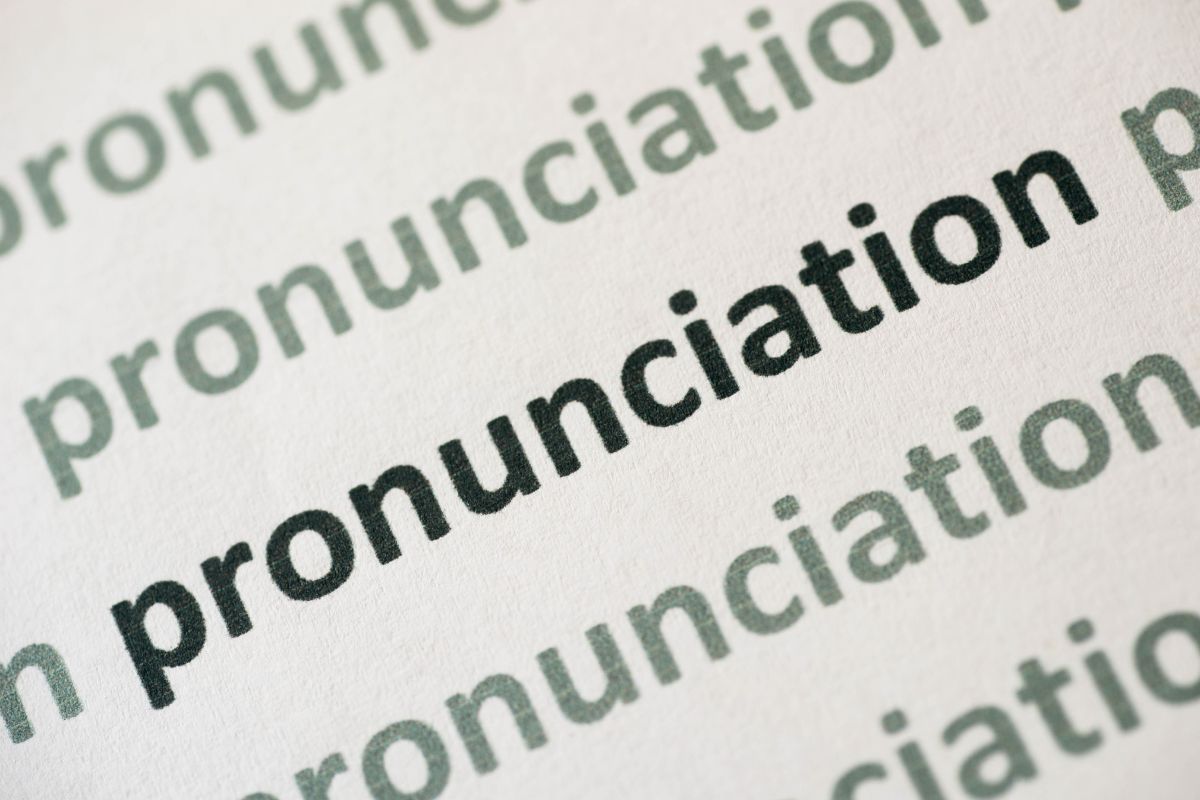Understanding English pronunciation guidelines is essential for clear communication and effective language learning.
Mastering how to pronounce words correctly can significantly impact comprehension and fluency in English.
Here is a curated list of the top 40 English pronunciation guidelines that everyone learning the language should know.
![a infographic about Top 40 English Pronunciation Guidelines You Must Know [2025]](https://phoenixenglishlang.com/wp-content/uploads/2024/02/unnamed-11.png)
Important Pronunciation Guidelines:
- Vowel sounds: English has multiple vowel sounds, and being aware of short and long vowels can change meanings (e.g., “bit” vs. “beat”).
- Consonant clusters: Certain combinations of consonants appear together in English without vowels in between (e.g., “str” in “street” or “spl” in “splash”).
- Silent letters: Many words include silent letters, which must be recognized for proper pronunciation (e.g., the “k” in “know” or the “b” in “thumb”).
- Word stress: Single words in English typically have one syllable that is stressed, which can influence meaning (e.g., ‘record as a noun vs. re‘cord as a verb).
- Sentence stress: In spoken English, key content words (nouns, main verbs, adjectives) are usually stressed while function words (the, and, but) are less emphasized.
- Intonation patterns: The rise and fall of voice when speaking can affect meaning. For instance, a rising intonation often indicates a question.
- Connected speech: Words often blend together in natural speech; for example, “want to” can be pronounced as “wanna.”
- Homophones: Be aware of words that sound the same but have different meanings and spellings (e.g., “to,” “too,” and “two”).
- The schwa sound: The most common vowel sound in English, represented as /ə/, occurs in unstressed syllables (e.g., “sofa”).
- Th sounds: The “th” sound can be pronounced as voiced (/ð/ as in “this”) or voiceless (/θ/ as in “think”), which can be challenging for non-native speakers.
- Ending consonants: Ensure that consonants at the end of words are pronounced clearly (e.g., the final “t” in “cat”).
- Linking sounds: When one word ends in a consonant and the next begins with a vowel, they often link (e.g., “turn it” sounds like “turnnit”).
- Diphthongs: Recognize the combination of vowel sounds in words such as “coin” or “out,” where two vowel sounds are blended.
- Stress in compound words: Compound words usually have the primary stress on the first part (e.g., “toothbrush” vs. “toothpaste”).
- Pronunciation of plurals: The pronunciation of the “s” at the end of plural forms can vary: /s/ in “cats,” /z/ in “dogs,” and /ɪz/ in “boxes.”
- -ed endings: The past tense “-ed” ending can be pronounced in three different ways depending on the preceding sound: /t/, /d/, and /ɪd/ (e.g., “hiked,” “called,” “needed”).
- Emphasis on adjectives: In certain contexts, adjectives can be emphasized to highlight their importance (e.g., “very important”).
- Weak forms: Some words, like “can” or “will,” change pronunciation in unstressed contexts (e.g., “I can go” versus “I can’t go”).
- The -ing ending: The ending “-ing” can be pronounced as /ɪŋ/ or sometimes as /ɪn/ in informal speech (e.g., “going” vs. “goin’”).
- Understanding regional accents: Recognize that pronunciation varies with regional accents which can influence vowel and consonant sounds.
- Tonal languages: Be aware that English is not a tonal language, but intonation does help convey emotion and emphasis.
- Ch and j sounds: The “ch” sound is pronounced like /tʃ/ in “chocolate,” whereas “j” is pronounced as /dʒ/ in “juice.”
- Word final syllables: Pay attention to how final syllables are pronounced in words (e.g., the difference between “depend” and “dependent”).
- Apostrophes in contractions: Contractions often change pronunciation, as in “I’m” pronounced as “I am” quickly (e.g., “I’m coming” vs. “I am coming”).
- Pronouncing foreign words: Some English words borrowed from other languages may retain original pronunciations (e.g., “déjà vu”).
- Common exemptions: Prepare for exceptions to pronunciation rules, as English has many irregular pronunciations (e.g., “bough” vs. “through”).
- Dialogue practice: Regularly practice dialogues and conversations to improve speaking and listening skills.
- Phonemic awareness: Understanding phonemes can help learners pronounce words correctly.
- Rhythm and flow: Work on the rhythm and flow of speech, as English often has a natural beat.
- Use of IPA: Familiarize yourself with the International Phonetic Alphabet (IPA) to understand pronunciation accurately.
- Recording yourself: Record your voice to analyze your pronunciation and progress over time.
- Learning syllable structure: Recognize how syllables are constructed and stressed to improve pronunciation accuracy.
- Pronounce with clarity: Focus on clear articulation, especially for challenging sounds and clusters.
- Minimal paired practice: Use minimal pairs (words that differ by only one sound) to practice distinguishing similar sounds.
- Listening and imitation: Listen to native speakers and try to imitate their pronunciation and intonation patterns.
- Articulatory exercises: Engage in facial and tongue exercises to strengthen pronunciation skills.
- Daily practice: Dedicate time every day to practice pronunciation through speaking and listening activities.
- Use visual aids: Use videos and charts that visually represent mouth positions for producing sounds.
- Engage with native speakers: Conversing with native speakers can provide real-time feedback and improve your natural pronunciation.
- Be patient and persistent: Recognize that improving pronunciation takes time and consistent effort; being patient will yield results.
You might also enjoy:Which of the Following: Definition + Complete Usage + Grammar
As we dive deeper into these top 40 English pronunciation guidelines, we will explore each point with more detail, offering practical examples and exercises to help reinforce what you learn. Knowing these guidelines not only helps learners gain confidence in their speaking abilities but also enhances their overall communication skills.
In the journey of mastering English, developing strong pronunciation skills is fundamental to achieving fluency and effective communication.
Understanding these 40 pronunciation guidelines offers invaluable insights that empower learners to articulate their thoughts more clearly and confidently.
Language is dynamic—pronunciation can significantly influence how ideas are conveyed and how one is perceived in conversation.
By mastering these guidelines, learners can minimize misunderstandings and improve interactions in both social and professional settings.
Engaging with these guidelines in an interactive way—through speaking out loud, listening exercises, and practical applications—will enrich the learning experience.
Utilizing tools such as language apps, listening to podcasts, or participating in conversation clubs can further reinforce these practices.
Moreover, becoming aware of and sensitive to pronunciation variations allows for a deeper appreciation of the richness and diversity within the English language.
As speakers immerse themselves in various dialects and accents, they broaden their own linguistic repertoire and adaptability.
Ultimately, focusing on pronunciation is not merely about sounding correct; it is about fostering effective communication and building connections through understandable speech.
By committing to these guidelines and embracing the practice, English learners can unlock the confident expression of their ideas, fostering successful interactions across different contexts and cultures.
By continually honing these skills, learners can set a solid foundation for their overall language proficiency, leading to not only improved speaking abilities but also greater enjoyment and fulfillment in their communication with others.
You Might Also Enjoy:Reinforce Vs Reenforce: 10 Differences + Examples [2025]
What is the best way to improve English pronunciation?

The best way to improve English pronunciation involves a combination of active listening, regular practice, and targeted exercises. Here’s a step-by-step guide:
1. Listen Actively
– Regularly expose yourself to native English speakers through podcasts, movies, TV shows, or audiobooks.
– Pay attention to different accents and speech patterns.
2. Imitate Native Speakers
– Mimic the pronunciation, rhythm, and intonation of native speakers.
– Repeat words, phrases, and sentences after them to practice.
3. Use Pronunciation Apps and Online Resources
– Explore apps and online resources designed for pronunciation practice.
– Many platforms offer interactive exercises, feedback, and audio examples.
4. Practice Minimal Pairs
– Work on distinguishing between minimal pairs, such as “ship” and “sheep.”
– Focus on sounds that may be challenging for non-native speakers.
5. Record Yourself
– Record your own speech and compare it to native speakers.
– Identify areas for improvement and track your progress over time.
6. Join Pronunciation Classes or Workshops
– Enroll in pronunciation classes or workshops led by language instructors.
– Receive guidance on specific sounds, stress patterns, and intonation.
7. Read Aloud
– Read English texts aloud to practice pronunciation and fluency.
– Choose a variety of materials, such as news articles, books, or dialogues.
8. Use Phonetic Transcription Tools
– Learn the International Phonetic Alphabet (IPA) to understand and practice specific sounds.
– Use phonetic transcription tools to analyze and improve pronunciation.
9. Engage in Conversations
– Practice speaking English with native speakers, language exchange partners, or language learners.
– Engage in real-life conversations to apply what you’ve learned.
10. Focus on Word Stress and Intonation
– Pay attention to word and sentence stress patterns.
– Practice varying your pitch to match natural English intonation.
11. Take Pronunciation Challenges Step by Step
– Identify and focus on one or two specific pronunciation challenges at a time.
– Gradually expand to more complex sounds or patterns.
12. Seek Feedback
– Request feedback from native speakers or language instructors.
– Use their insights to refine and improve your pronunciation.
Remember that consistent and focused practice is key to improvement. Incorporate these strategies into your daily routine, and over time, you’ll see progress in your English pronunciation.
You might also enjoy:Where Does “How is your Day Going?” Originate From?
What helps make pronunciation easier?

Several strategies can make English pronunciation easier for learners:
1. Phonetic Awareness
– Familiarize yourself with the International Phonetic Alphabet (IPA) to understand the sounds of English.
2. Listen Actively
– Regularly expose yourself to native English speakers through listening to podcasts, movies, or audiobooks.
– Pay attention to how words and sentences are pronounced in various contexts.
3. Practice Regularly
– Consistent and regular practice is crucial for improvement. Include pronunciation exercises in your daily language routine.
4. Break Down Words
– Break longer words into syllables to make pronunciation more manageable.
– Focus on pronouncing one syllable at a time before combining them.
5. Use Pronunciation Guides
– Utilize dictionaries or online resources that provide audio examples and pronunciation guides for words.
– Pay attention to stress patterns and accents.
6. Record Yourself
– Record your own speech to identify areas for improvement.
– Compare your pronunciation to native speakers and adjust accordingly.
7. Focus on Common Sounds
– Begin by mastering common sounds in English before tackling more challenging ones.
– Pay attention to vowels, consonants, and their combinations.
8. Understand Word Stress
– Recognize the importance of word stress in English.
– Practice emphasizing the correct syllable to improve overall pronunciation.
9. Use Mnemonics
– Create mnemonics or memory aids to remember the correct pronunciation of specific words or sounds.
10. Engage in Conversations
– Practice speaking with native speakers, language exchange partners, or language learners.
– Apply what you’ve learned in real-life situations.
11. Watch Articulation Videos
– Online platforms often have videos that demonstrate the correct mouth and tongue movements for specific sounds.
12. Use Technology
– Explore pronunciation apps or online platforms that provide interactive exercises and instant feedback.
13. Join Pronunciation Classes
– Enroll in pronunciation classes or workshops led by experienced language instructors
14. Celebrate Small Wins
– Acknowledge and celebrate your progress, even with small improvements.
– Building confidence can positively impact pronunciation.
Remember that making pronunciation easier is a gradual process. Be patient, stay motivated, and adjust your approach based on your specific challenges and progress.
You might also enjoy:Interested In or On: The Differences + Examples [2025]
How long does it take to improve English pronunciation?

The time it takes to improve English pronunciation varies widely depending on individual factors such as language background, exposure to English, practice habits, and the specific challenges faced. There isn’t a fixed timeframe, and improvement is a gradual process.
Factors influencing the speed of improvement include:
- Consistency: Regular, consistent practice is crucial for improvement. Daily practice is often more effective than sporadic, intensive sessions.
- Intensity of Practice: Engaging in diverse and targeted pronunciation exercises can expedite improvement.
- Feedback and Correction: Regular feedback, whether from language instructors, native speakers, or self-assessment, helps in identifying and correcting pronunciation errors.
- Exposure to Native Speakers: Immersing oneself in environments with native English speakers, either through real-life interactions or media consumption, can accelerate improvement.
- Previous Language Learning Experience: Individuals with experience learning multiple languages may find it easier to adapt to new phonetic systems.
- Awareness and Willingness to Adapt: Being mindful of pronunciation challenges and actively seeking ways to overcome them contributes to faster improvement.
It’s important to approach pronunciation improvement as a continual process rather than a destination.
Over several weeks or months of consistent and focused practice, learners often notice significant enhancements in their pronunciation skills.
Regular self-assessment and adjustments to learning strategies can help ensure ongoing progress.
You might also enjoy:What Kind of Vs What Kinds of – Differences + Examples [2025]
Essay about english pronunciation guidelines

English pronunciation guidelines play a crucial role in effective communication, ensuring clarity and understanding among speakers of this globally spoken language.
These guidelines encompass various aspects, including vowel and consonant sounds, stress patterns, and intonation.
Vowel sounds in English are diverse, requiring learners to grasp nuances such as short and long vowels, diphthongs, and vowel modifications.
Consonant sounds, ranging from plosives to fricatives, add further complexity. Proper articulation is essential for accurate pronunciation.
Stress patterns contribute significantly to spoken English, influencing the meaning of words and sentences.
Mastering stress placement aids in conveying intended messages, highlighting key information, and avoiding ambiguity.
Intonation, the rise and fall of pitch in speech, contributes to the overall meaning and emotion conveyed.
English speakers often use intonation to express questions, statements, or excitement, emphasizing the importance of understanding its role in effective communication.
Pronunciation guidelines serve as a bridge to cultural understanding, facilitating clearer communication among diverse English speakers.
Mastery of these guidelines enhances language proficiency, fostering effective expression and comprehension.
What are the 6 steps to improve English pronunciation?
- Phonetic Awareness: Develop an understanding of English phonetics, including vowel and consonant sounds. Familiarize yourself with the International Phonetic Alphabet (IPA) to accurately represent and reproduce sounds.
- Listen and Imitate: Surround yourself with native English speakers by listening to podcasts, audiobooks, or watching movies and TV shows. Imitate the pronunciation, paying attention to intonation, stress patterns, and rhythm.
- Practice Pronunciation Exercises: Engage in specific exercises that target challenging sounds or patterns. Repeat words, phrases, and sentences focusing on correct pronunciation. Utilize online resources or language learning apps that provide pronunciation practice.
- Receive Feedback:Seek feedback from native speakers, language teachers, or language exchange partners. They can pinpoint areas for improvement and offer guidance on refining your pronunciation.
- Use Pronunciation Guides:Leverage pronunciation guides, dictionaries, or online tools that provide audio examples of words. Many dictionaries offer phonetic transcriptions, aiding in accurate pronunciation.
- Record Yourself:Record your speech and listen critically to identify areas needing improvement. Compare your recordings to native speakers or pronunciation models. Regular self-assessment enhances your awareness and allows for continuous refinement.
Consistent practice and a proactive approach to addressing specific pronunciation challenges will contribute to significant improvement over time.
You might also enjoy:How Are You Fairing or Faring? Differences + Examples
What are the essentials of English pronunciation?

The essentials of English pronunciation include:
- Phonetic Sounds: Mastery of the various phonetic sounds in English, including vowels, consonants, diphthongs, and other unique sound combinations.
- Stress Patterns: Understanding and applying stress patterns in words and sentences. English is a stress-timed language, and placing emphasis on the correct syllables is crucial for clarity.
- Intonation: Grasping the rise and fall of pitch in speech to convey meaning, express questions, or indicate different moods.
- Linked Speech: Recognizing how words connect in spoken English, as sounds often blend together or change depending on their placement in a sentence.
- Rhythm and Pace: Developing a natural rhythm and pace in speech, avoiding monotony or excessive speed. This contributes to overall fluency and comprehension.
- Word Endings: Paying attention to the correct pronunciation of word endings, including plural forms, verb conjugations, and other suffixes.
- Listening Skills: Cultivating strong listening skills by exposing oneself to native English speakers, whether through conversations, podcasts, or other audio sources.
- Modeling and Imitation: Learning from pronunciation models, native speakers, or audio resources to refine one’s own pronunciation through imitation.
- Feedback and Correction: Actively seeking feedback on pronunciation, identifying areas for improvement, and correcting errors to enhance overall proficiency.
- Consistent Practice: Engaging in regular and focused practice, as consistent effort is key to improving pronunciation skills over time.
By addressing these essentials, learners can develop a solid foundation for accurate and effective English pronunciation.
Improving English pronunciation in 7 easy steps
Improving English pronunciation is a gradual process, but you can make significant progress with consistent effort. Here are seven steps to help you enhance your English pronunciation:
- Phonetic Awareness: Familiarize yourself with English phonetic sounds, including vowels, consonants, and diphthongs. Understand the International Phonetic Alphabet (IPA) to accurately represent sounds.
- Listen Actively:Immerse yourself in English audio materials such as podcasts, audiobooks, or movies. Pay close attention to native speakers’ pronunciation, stress patterns, and intonation.
- Repeat and Imitate:Practice repeating words, phrases, and sentences after native speakers. Focus on mimicking their pronunciation, rhythm, and intonation to enhance your own speech.
- Use Pronunciation Guides:Utilize online dictionaries, language learning apps, or pronunciation guides that provide audio examples and phonetic transcriptions. These resources can help you refine your pronunciation.
- Record Yourself: Regularly record your own speech and listen for areas of improvement. Compare your recordings to native speakers or pronunciation models, and adjust accordingly.
- Seek Feedback:Engage with native speakers, language exchange partners, or language teachers for constructive feedback. External input is valuable for identifying specific areas to work on.
- Practice Regularly:Consistency is key. Dedicate time each day to practice pronunciation exercises, listen to English content, and engage in conversations to reinforce what you’ve learned.
You might also enjoy:Too Cute Meaning Vs To Cute (To Vs Too) + Examples
How do you pronounce actually in English?

The word “actually” is typically pronounced as /ˈæk.tʃu.ə.li/ in English. The stress is on the first syllable, and the pronunciation involves a short ‘a’ sound, followed by the ‘kt’ cluster, and ending with a schwa sound in the last syllable.
Does English have pronunciation rules?
Yes, English does have pronunciation rules, but they can be complex due to the language’s historical development and influences from various sources. Some key pronunciation rules include:
- Phonetic Sounds: Understanding the pronunciation of individual phonetic sounds, both vowels and consonants, and recognizing their variations in different contexts.
- Stress Patterns: Recognizing where to place stress within words and sentences. English is a stress-timed language, meaning stressed syllables are emphasized more than unstressed ones.
- Intonation:Grasping the rise and fall of pitch in speech to convey meaning, express questions, or indicate different moods.
- Linked Speech: Understanding how words connect in spoken English, as sounds often blend together or change based on their placement in a sentence.
- Silent Letters:Learning when certain letters are silent in words, as English has many instances where letters are not pronounced.
- Word Endings:Paying attention to the correct pronunciation of word endings, including plural forms, verb conjugations, and other suffixes.
- Vowel Modifications:Recognizing how vowel sounds can change based on surrounding consonants or syllable stress.
While these rules provide a foundation, English pronunciation can still be challenging due to exceptions and irregularities. Exposure to native speakers, consistent practice, and using resources like dictionaries with audio pronunciations can aid in mastering these rules.
You might also enjoy:How Are You Fairing or Faring? Differences + Examples
How do British people pronounce literally?
In British English, the word “literally” is typically pronounced as /ˈlɪtərəli/. The stress is on the second syllable, and it is pronounced with a short ‘i’ sound in the first and second syllables, followed by a schwa sound in the third syllable. The final “y” in “literally” is pronounced as a short ‘i’ sound.
The word “guidelines” is pronounced as /ˈɡaɪdlaɪnz/ in English. The stress is on the first syllable, and the pronunciation involves a long ‘i’ sound in the second syllable. The “g” at the beginning is pronounced like the ‘g’ in “go.”
“English pronunciation guidelines” refer to a set of instructions or recommendations designed to assist individuals in achieving accurate and effective pronunciation of the English language.
These guidelines cover various aspects, including the correct articulation of phonetic sounds, stress patterns within words and sentences, intonation, and other factors influencing spoken English.
The purpose of these guidelines is to provide learners with a structured approach to improving their pronunciation skills, aiding in clear communication and comprehension.
They serve as a reference for mastering the nuances of English pronunciation and are often used in language learning materials, courses, or resources to support individuals in their journey to articulate sounds and express themselves more accurately in spoken English.
In American English, pronunciation guidelines include recommendations and rules for accurately pronouncing sounds, words, and sentences. Some key aspects of American English pronunciation guidelines are:
- Rhoticity:American English is generally rhotic, meaning the “r” sound is pronounced at the end of words and before consonants.
- Vowel Sounds: American English has distinct vowel sounds, and certain vowels may be pronounced differently than in other English varieties. For example, the “r” sound can affect vowel pronunciation.
- Stress Patterns:Understanding stress patterns within words and sentences is crucial. American English tends to emphasize certain syllables, impacting the overall rhythm of speech.
- Consonant Pronunciation:Clarity in pronouncing consonants, including distinctions between voiced and voiceless sounds, contributes to effective communication.
- Intonation: American English has specific intonation patterns, with rising and falling tones conveying different meanings. Understanding these patterns enhances spoken communication.
- Linked Speech: Recognizing how words link together in spoken sentences, with certain sounds changing or blending based on their context, is important for natural-sounding speech.
- Regional Variations:It’s worth noting that American English has regional accents and variations. Pronunciation guidelines may vary slightly depending on the region.
For learners aiming to master American English pronunciation, exposure to native speakers, practice with authentic materials, and utilizing resources such as pronunciation guides and language learning apps can be beneficial.
“Application guidelines” typically refer to a set of instructions or recommendations outlining the steps and requirements for applying to a program, position, or opportunity.
These guidelines are designed to assist individuals in the application process and often cover various aspects, including:
- Application Procedures:Clear instructions on how to submit an application, including any required forms, documents, or online portals.
- Eligibility Criteria:Criteria that applicants must meet to be considered for the opportunity. This may include educational qualifications, work experience, or other specific requirements.
- Submission Deadlines:Clearly defined deadlines for submitting applications to ensure timely consideration.
- Required Materials:A list of documents or materials that applicants must include with their application, such as a resume, cover letter, academic transcripts, letters of recommendation, etc.
- Selection Criteria:Information on the criteria used to evaluate and select candidates. This may include specific skills, qualities, or experiences sought in successful applicants.
- Contact Information: Details on how to contact the organization or entity overseeing the application process for inquiries or additional information.
- Application Review Process: An overview of how applications will be reviewed and the timeline for notifying applicants about the status of their application.
These guidelines are crucial for ensuring a fair and organized application process, providing transparency for applicants and facilitating effective communication between applicants and the entity overseeing the opportunity.
You Might Also Enjoy: Top 60 Most Common Simple Sentences In English
Why is pronunciation important in English language learning?

Pronunciation is crucial in English language learning for several reasons:
- Clarity of Communication:Accurate pronunciation ensures that your spoken words are understood correctly by others. It minimizes misunderstandings and facilitates effective communication.
- Expressing Intent:Proper pronunciation allows learners to convey their thoughts, feelings, and intentions accurately. It enhances the ability to express oneself in a way that matches the intended meaning.
- Listening Comprehension:Developing good pronunciation skills aids in understanding spoken English, especially when interacting with native speakers, watching movies, or engaging in conversations. It improves overall listening comprehension.
- Social and Professional Interaction: Clear pronunciation is essential in social and professional contexts. It contributes to building positive relationships, both personally and in the workplace.
- Cultural Integration:Pronunciation is closely tied to the cultural aspects of a language. A well-pronounced language helps learners integrate into English-speaking communities more seamlessly.
- Reducing Language Barriers:Effective pronunciation helps in overcoming language barriers. Whether traveling, studying, or working in an English-speaking environment, good pronunciation facilitates smoother interactions.
- Boosting Confidence:Mastering pronunciation boosts learners’ confidence in using the language. Feeling confident in speaking encourages more active participation and engagement in language learning activities.
- Enhancing Language Proficiency:Pronunciation is a fundamental aspect of overall language proficiency. Neglecting it may impede progress and limit one’s ability to reach higher levels of fluency.
In summary, pronunciation plays a vital role in language learning by fostering clear communication, aiding comprehension, and contributing to learners’ overall language proficiency and confidence.
You might also enjoy:Emersion Vs Immersion: Meaning, Differences, and Examples
What are the pronunciation skills?

Pronunciation skills encompass various aspects that contribute to the accurate and effective vocalization of sounds, words, and sentences in a language. Key pronunciation skills include:
- Phonetic Awareness: Recognizing and producing the distinct sounds of a language, including vowels, consonants, and other phonetic elements.
- Stress Patterns:Understanding and applying stress patterns within words and sentences to convey meaning and emphasize specific syllables.
- Intonation: Grasping the rise and fall of pitch in speech to express different moods, convey questions, or indicate emphasis.
- Rhythm and Pace: Developing a natural rhythm and pace in speech, avoiding monotony, and ensuring appropriate speed for effective communication.
- Linking and Blending: Understanding how words connect in spoken language, including instances of linking sounds and blending words together.
- Vowel and Consonant Modifications:Recognizing variations in vowel and consonant sounds based on word context, stress, and surrounding sounds.
- Word Endings: Pronouncing word endings accurately, including plurals, verb conjugations, and other suffixes.
- Fluency:Achieving smooth and fluent speech by combining accurate pronunciation with appropriate pacing and rhythm.
- Listening Skills:Developing strong listening skills to accurately perceive and imitate the pronunciation of native speakers.
- Phonetic Transcription:Familiarity with phonetic symbols and transcription systems, such as the International Phonetic Alphabet (IPA), to represent pronunciation accurately.
Improving these pronunciation skills requires practice, exposure to native speakers, and, at times, guidance from language learning resources or instructors. Consistent effort in honing these skills contributes significantly to overall language proficiency and effective communication.

Hi, welcome to my blog! My name is Omid and I am thrilled to have you here! I am an English language teacher with 12 years of experience and hold multiple international certifications (TESOL, IELTS, TOEFL, PTE, CELTA). Additionally, I hold a PhD in Applied Linguistics with a specialization in Teaching English as a Second Language (TESL), which fuels my passion for teaching English and assisting others in mastering the language. To me, nothing is more rewarding than helping individuals enhance their English language abilities through various methods. So, let’s embark on this journey of learning English together.




